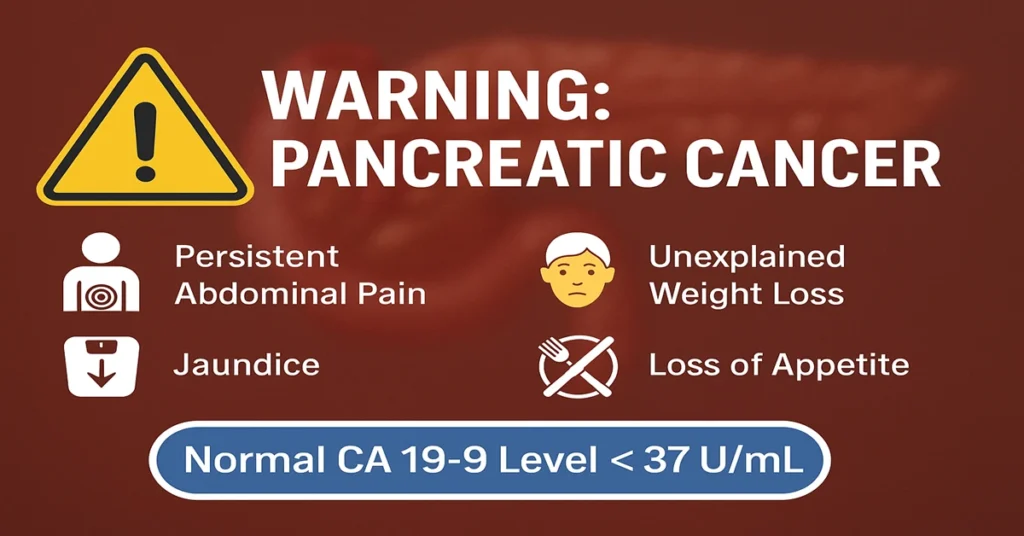Overview
CA19-9, or Cancer Antigen 19-9, is a protein (tumor marker) found in the blood. It is most commonly associated with pancreatic cancer, but levels can also rise in other cancers such as bile duct, gallbladder, stomach, or colon cancer, and even in certain non-cancerous liver and digestive disorders.
Doctors use the CA19-9 blood test mainly to monitor treatment response, disease progression, and cancer recurrence, rather than as a screening tool for early detection.
What is CA19-9?
CA19-9 is a glycoprotein (a protein combined with carbohydrate molecules) that is released into the blood by specific cells in the digestive system.
It was first discovered in the 1980s and soon became a valuable biomarker for tracking pancreatic and gastrointestinal cancers.
A tumor marker like CA19-9 is a substance that can be found at higher-than-normal levels when cancer or other abnormal cell activity is present. However, high CA19-9 alone does not confirm cancer, so it must always be interpreted along with imaging tests and medical examination.
Where is CA19-9 Produced in the Body?
CA19-9 is naturally produced by the epithelial cells that line organs of the digestive and biliary systems, including:
- Pancreas – the main site of production
- Bile ducts – tubes that carry bile from the liver and gallbladder
- Gallbladder
- Stomach
- Colon and intestines
- Salivary glands (in smaller quantities)
It is also present in mucus secretions of the gastrointestinal tract. When inflammation, obstruction, or cancer affects these organs, the amount of CA19-9 released into the blood increases.
Functions and Clinical Importance of CA19-9
CA19-9 does not play a functional role in the body but serves as an important clinical marker for various conditions.
1. Cancer Monitoring
- It is widely used to monitor the treatment of pancreatic cancer.
- Regular blood tests show whether the tumor is shrinking or growing during therapy.
2. Diagnostic Support
- Helps support the diagnosis of suspected cancers, especially of the pancreas, bile ducts, or gallbladder, in combination with imaging (CT, MRI, ultrasound).
3. Disease Progression Marker
- A rising CA19-9 level may indicate that the disease is progressing or spreading to other parts of the body.
4. Non-Cancer Conditions
- Elevated levels may also suggest bile duct blockage, gallstones, or liver inflammation such as hepatitis or cirrhosis.
Low or Normal CA19-9 Levels
Causes of Low Levels
- Normal or low levels are typical in healthy individuals.
- In patients under treatment for cancer, a drop in CA19-9 usually means that therapy is effective.
- Some people naturally have no measurable CA19-9 due to genetic absence of the Lewis antigen, and the test is less useful for them.
Symptoms of Low CA19-9
- There are no symptoms associated with low or normal levels.
- It simply indicates that there is no abnormal activity or the treatment is working well.
High CA19-9 Levels (Elevated CA19-9)
Elevated CA19-9 levels can occur in both malignant (cancerous) and benign (non-cancerous) diseases.
Cancer-Related Causes
- Pancreatic cancer – the most common cause
- Bile duct cancer (cholangiocarcinoma)
- Gallbladder cancer
- Stomach (gastric) cancer
- Colorectal cancer
- Liver cancer (less commonly)
Non-Cancerous (Benign) Causes
- Pancreatitis (acute or chronic) – inflammation of the pancreas
- Gallstones or bile duct blockage
- Cirrhosis or hepatitis – chronic liver conditions
- Cystic fibrosis – a genetic condition affecting mucus and digestion
- Inflammatory bowel disease (IBD) – including Crohn’s disease and ulcerative colitis
Symptoms of High CA19-9
High CA19-9 itself does not cause any symptoms. However, the underlying disease responsible for the elevation may produce signs such as:
- Persistent abdominal pain or discomfort
- Jaundice (yellowing of skin and eyes due to bile obstruction)
- Loss of appetite or early fullness after meals
- Unexplained weight loss
- Nausea and vomiting
- Fatigue or weakness
If any of these symptoms persist, medical evaluation is essential.
CA19-9 Reference Ranges (Blood Levels)
| Level Category | CA19-9 (U/mL) | Interpretation |
|---|---|---|
| Normal | < 37 U/mL | Healthy or no significant disease |
| Borderline | 37 – 100 U/mL | Possible benign or early disease |
| High | > 100 U/mL | Likely significant disease or cancer |
Note: A single elevated value does not confirm cancer. Results must be interpreted with other clinical findings and imaging studies.
Sample Type and Collection
- Sample Type: Serum (blood sample)
- Tube Used: Red-top (plain) tube
- Fasting Required: No
- Processing Time: 1–2 days
The test can be repeated periodically to monitor disease progress or treatment success.
Test Preparation
- No special preparation is required before giving the blood sample.
- Inform your doctor about any ongoing medications or biliary obstruction symptoms.
- Avoid testing soon after a surgery or infection, as it may temporarily raise CA19-9 levels.
When to Consult a Doctor
You should seek medical advice if you have:
- Persistent upper abdominal pain or bloating
- Jaundice or dark urine
- Unexplained weight loss or appetite loss
- Chronic nausea, vomiting, or indigestion
- A family history of pancreatic or gastrointestinal cancer
Consultation is especially important if CA19-9 levels remain high or keep increasing in follow-up tests.
Important Word Explanations
- Tumor Marker: A substance produced by cancer or by the body in response to cancer.
- Pancreatic Cancer: Cancer that begins in the pancreas, an organ involved in digestion and blood sugar regulation.
- Bile Ducts: Tubes that carry bile from the liver and gallbladder to the intestine.
- Jaundice: Yellowing of skin and eyes due to bilirubin buildup.
- Cirrhosis: Scarring of the liver caused by chronic liver disease.
- Cystic Fibrosis: Genetic disease affecting the lungs and digestive system.
- Benign: Non-cancerous; not life-threatening.
- Recurrence: Reappearance of cancer after treatment.
~END~

